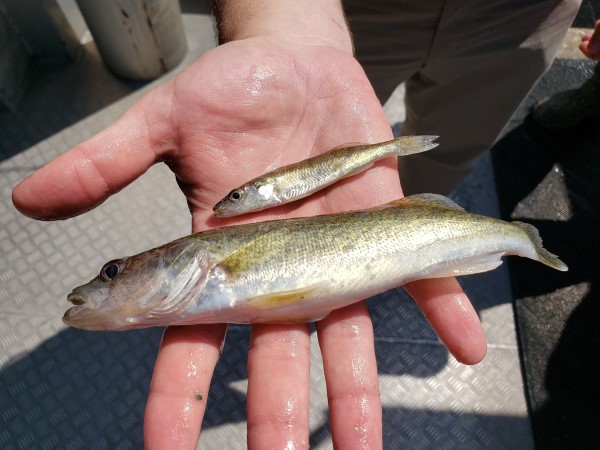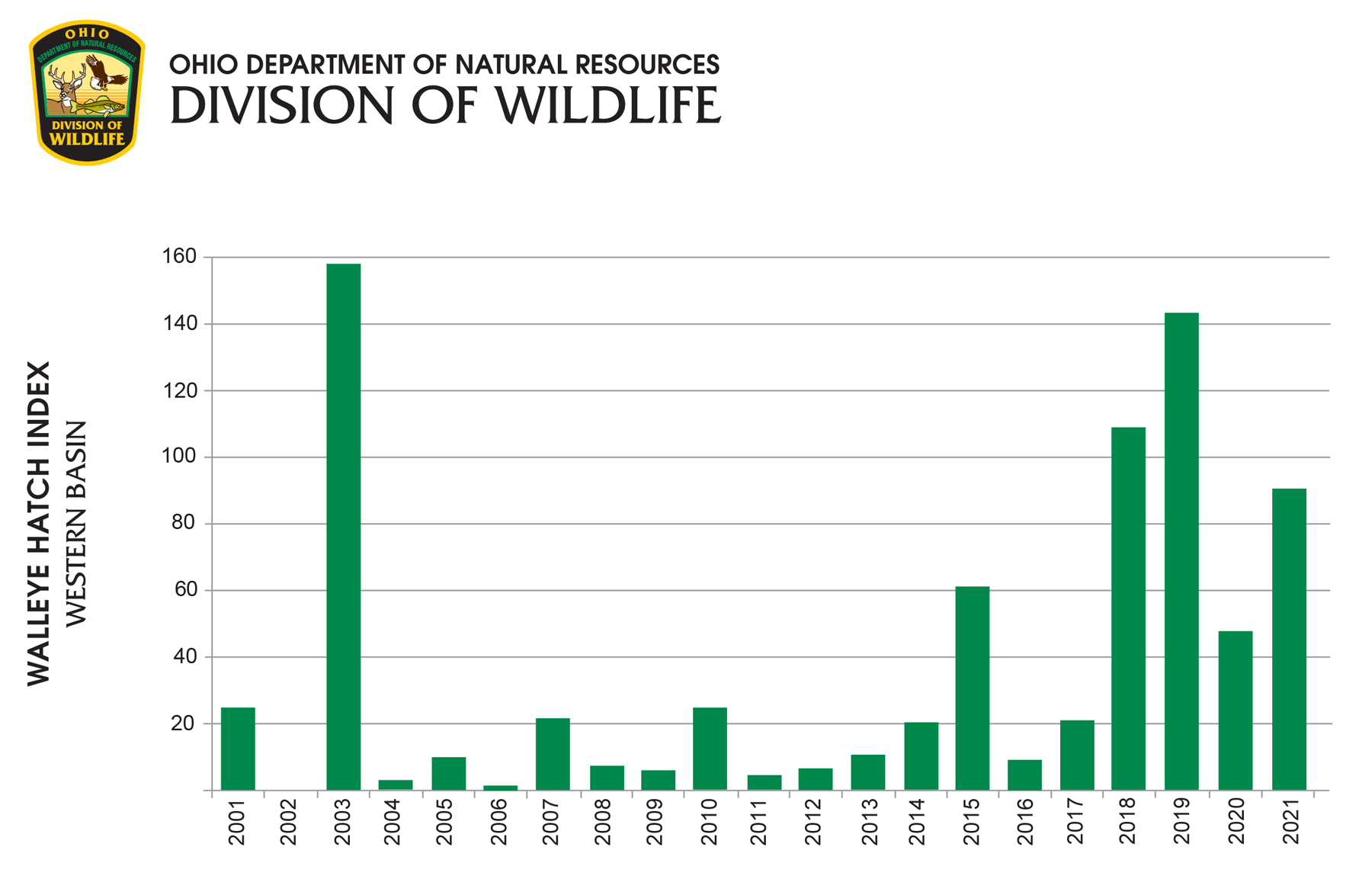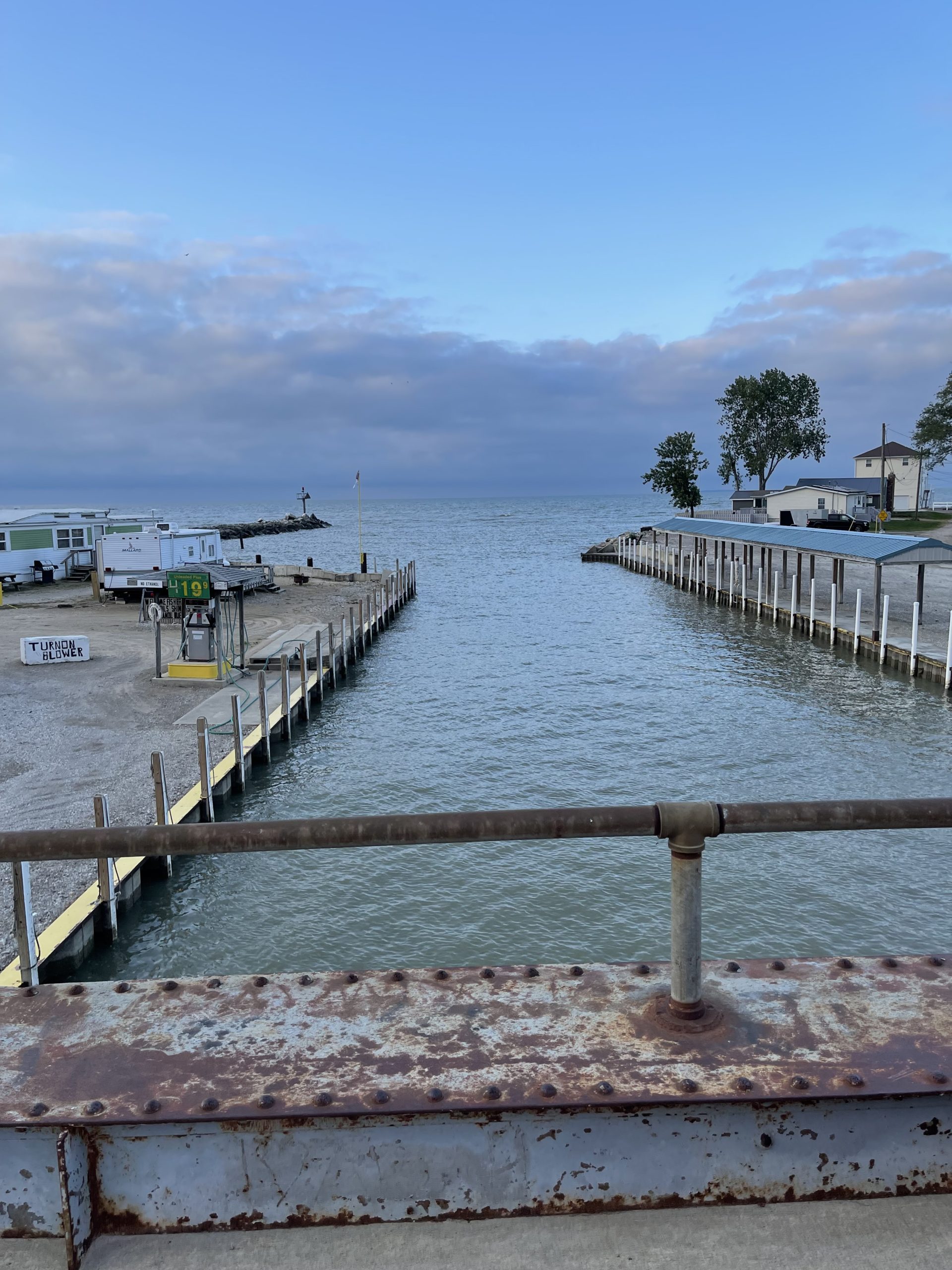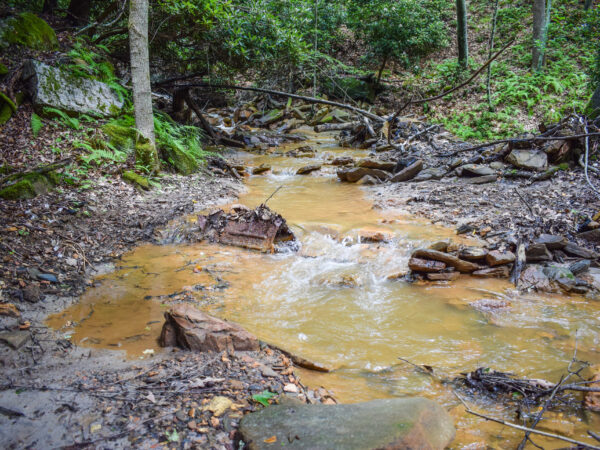
Correction: An earlier version of this story incorrectly stated the current creel limit for walleye in Ohio.
Lake Erie, so far as modern fisheries biologists are concerned, has never been so flush with walleye.
The Ohio Department of Natural Resources estimates there are currently about 95 million walleye in the lake two years old or older – that translates into fish about 15 inches or longer, the minimum size for keeping and eating.
But that number does not include the tens of millions of small fish, called young-of-year, from this spring’s spawning events. Those fish are the ones scientists counted late this summer to determine the annual walleye hatch index. Four of the past seven walleye hatches have been above average and even exceptional, including two of the largest ever sampled. It also does not include the tens of millions that are older than one year but not yet two, which are caught frequently but must be released.

Ohio Division of Wildlife Chief Kendra Wecker (Photo provided by the Ohio Department of Natural Resources)
“This is fantastic news for Lake Erie and the future of the fishery,” said Kendra Wecker, Ohio Division of Wildlife chief. “This hatch will reach harvestable size during the 2023 fishing season. In the meantime, with an incredible run of strong hatches beginning in 2015, there has never been a better time to fish Lake Erie. Anglers can find an abundance of walleye averaging 20 inches, reaching up to 26 inches or more.”
People in the tourism industry are pretty happy about the most recent survey.
“We already have a population of walleye with record numbers and then we get a fifth-highest hatch in the past 35 years,” said Larry Fletcher, director of Lake Erie Shores and Islands, a regional visitors bureau in Ottawa and Erie counties. “As we move forward, this fishery will become even more important and will draw even more people here.”
What’s the hatch index and how is it created?
Every year fisheries managers in Ohio and Ontario work together to determine how many new walleye are in the lake. Each state’s staff set out to perform 35-plus trawls along the lake bottom at various sites, dropping large nets and dragging them slowly for ten minutes along the lake bottom, scooping up and counting the young-of-year walleye. Ohio has been using the same sites and techniques since 1987 and those late-summer trawl results determine the hatch index.
Each year those results offer a glimpse into the likely future of walleye populations by calculating the number of fish that were born after the spring spawning season, and which survived until late summer, now about four inches long.

Fisheries biologist holds two trawl-caught walleye during survey. The top fish is about 4 inches long and was hatched in the spring. The bottom fish is about 18 months old and 8 inches. (Provided by the Ohio Department of Natural Resources)
For more than a decade, the 2003 hatch was considered the hallmark on Lake Erie, with nearly 160 fish estimated per hectare (about 2.5 acres) and remains the largest recorded hatch. Anglers are still pulling those fish from the lake on occasion, with many measuring 30 inches or more.
After that, from 2004 through 2017, there was a serious walleye drought. DOW biologists’ trawls for the next 14 years saw low numbers averaging about 16 walleye per hectare.
Beginning in 2018, a dramatic shift took place, with walleye trawl numbers skyrocketing. Between 2018 and 2021, those trawl numbers averaged nearly 100 fish per hectare, a nearly sixfold increase. The most recent Ohio survey, the 2021 survey, indicated about 90 fish per hectare – nearly triple the current 20-year running average of 34 fish. That’s the fifth-largest hatch index number in 35 years.
Later this year, Ohio biologists will combine their data with findings from Ontario for a final number. That number will be used by the Lake Erie Commission to determine a total allowable catch, or TAC. Ontario, Michigan, Ohio, New York and Pennsylvania wildlife officials then use that number to determine commercial fishing quotas and creel limits for sport anglers.

Lake Erie walleye hatch numbers in Ohio waters since 2001. (Provided by the Ohio Department of Natural Resources)
Related stories on Great Lakes Now:
Tips, Tricks, Recipes: Want to know how to eat Great Lakes fish?
Walleye: Lake Erie population skyrockets. Again.
No single explanation for recent years’ exceptional hatches
“Our numbers pretty much mirror exactly what Ohio is seeing,” said Jim Francis, the Lake Erie basin coordinator for the Michigan Department of Natural Resources. “The 2018, 2019, 2020 and 2021 year classes are just really, really good.”
When Great Lakes Now asked Francis what his department was doing to promote these hatches, he laughed.
“That’s the $64,000 question, right? There’s a lot of variables that determine year-class production. A lot of it’s weather patterns,” he explained.
Francis had another theory for the booming walleye populations.
“I don’t know if there’s anything to it, but there’s certainly a correlation between when it happened last,” he added. “It was in the early to mid-80s and we had similar high water levels back at that time too, so I’m not necessarily saying there’s a cause and effect, but there’s certainly some correlation.”
Travis Hartman, the Lake Erie fisheries program coordinator, echoed the high water sentiments, saying that he believes high water levels may lead to more nursery habitat for tiny walleye to survive in.
“At the end of the day, it’s having the plankton food they need available when they hatch so they can start eating,” he said. “Once that yolk sac is used up there has to be a plankton bloom. I think this high water is a part of it. We have a lot of productivity when we have high water.”
The largest plankton species are visible to the naked eye, he said, but most are minuscule, like you’d see looking at a water sample through a microscope. Those plankton feed on algae that are present in the spring. And more plankton blooms equals more walleye food. Whether the plankton are feeding on algae that is a product of agricultural runoff in the spring, Hartman could not say.
“I’m not a nutrients scientist and I can’t tell you what specific conditions and types of nutrients are right,” he said. “I know that right now we have plenty of food and larval walleye are taking advantage of it.”

Ohio Gov. Mike DeWine listens to fish tales at the 2021 Fish Ohio Day in Port Clinton. (Photo Credit: James Proffitt)
Theories abound
Ottawa County is home to most of the Lake Erie charter boat fleet, which tops 800 vessels and includes plenty more licensed captains and their first mates. Big trawl numbers have been a yearly treat for those in the fishing business there recently. And everyone has their own take on it.
Captain Jason McCann is a third-generation captain, running Legacy Charters out of the Portage River in Port Clinton, Ohio.
“I think the zebra mussels have created more breeding grounds, that’s my hypothesis,” he said. “It seems like they’re breeding more along the shorelines now, anywhere there’s any rock or structure. I’m not a scientist, so I’m better at catching them than explaining them. It just seems like you catch them on the beaches a ton more than you used to.”
Hartman said McCann’s theory may hold water – and spawning walleye.
“In the Western Basin they’ve historically found eggs anywhere less than 20 feet and that has the right substrate,” Hartman said. “If you look at areas like Maumee Bay that used to be more muddy or sandy bottom but now have zebra mussels, we definitely have potentially created spawning habitat with zebra mussels colonizing in areas that didn’t previously have rocks.”

Marblehead-based Reefrunner Lures is just one of dozens of Port Clinton-area businesses that depend on walleye. (Photo Credit: James Proffitt)
Larry Weiss has been operating Fish and Fowl Adventures out of Lorain, Ohio, for 15 years.
“Yeah, I can’t complain about those numbers,” he said. “But I don’t think we’ve gotten more business because the walleye fishing’s better. I think business is better for many reasons. I don’t think most of the customer base is out to catch a limit – most don’t even know what the limit is when they board the boat. They’re just out to have a fun day.”
Weiss said whatever happens during the next few years, walleye fishing should be great.
“I don’t know what’s going to happen with the hatch, I’m not a biologist,” he said. “But it’s probably weather-dependent. I don’t think it matters now as long as there’s no catastrophic die-off, there’s so many fish in the system now to see us through a good 10 years of solid fishing.”
Too many walleye?
Julia Davis, known professionally as Capt. Juls, has been operating out of a Ranger walleye boat in the Port Clinton area for a decade. She stays mobile, moving between the Western Basin and Lorain chasing fish. Juls said she’s seen intra-species predation.
“We’ve caught some walleye that have a lot of baby walleye in their bellies,” she said. “They’re opportunistic and they’re going to eat whatever they can.”
The forage base populations, smaller fish like emerald shiners, gizzard shad, white perch and rainbow smelt, come and go, according to DOW surveys. Up one year, down dramatically the next, then up again. But Francis said walleye eating walleye shouldn’t be a major concern.
“I have not heard of that, but yeah, big fish eat little fish, that’s what happens,” he said. “The main thing we’re looking at in our young-of-year surveys in the fall is we’re looking at how many fish were hatched in the spring, but it also gives us a good idea of how many fish were hatched the previous year. So what we can do is compare and make sure those fish continue to show up, and so there’s a pretty good indication of the fact there’s not a serious problem of walleye eating walleye and that they’ll continue to carry themselves through.”
According to Francis, MDNR surveys show that the diet of walleye they’ve surveyed recently show a steady consumption of forage fish, with a few yellow perch and walleye thrown in.
“We always get the question ‘Is there enough food out there for them?’ because in Saginaw Bay we’ve seen a big increase in walleye population and a decline in yellow perch numbers, and so there’s a concern,” Francis said. “People try to make the connection and think there may be a problem in Lake Erie. But we’re not seeing that. We do a diet analysis and we’re not seeing a lot of small perch and small walleye.”
In Michigan waters, Francis said, there are plenty of shiners, shad and white perch for the expanding walleye population.

Boat docking and access to Lake Erie is a major business in Ottawa County, which boasts more than 20,000 boat slips. (Photo Credit: James Proffitt)
With more fish, will creel limits rise?
As walleye populations rise, anglers often pepper fisheries managers with questions about raising the total daily limits. But that’s not likely next year, officials say.
Up until spring 2020 in Ohio, the limit was four walleye in the Maumee and Sandusky rivers during the spring spawn and six in Ohio’s Lake Erie waters. Due to successful walleye hatches, the Maumee River spring limit was raised to six. This year, the limit for the Sandusky River was raised to six also, making Ohio’s Lake Erie waters and tributaries creel limit six fish all year.
Currently the TAC for walleye from the binational Lake Erie Committee is 12.84 million fish. But in the future, Hartman said, even if that number rises above 13 million fish, the creel limit for Ohio sport anglers is unlikely to change anytime soon – six is the maximum for the foreseeable future.
It could depend on how much time is spent fishing for walleye, combined with harvest rate. Hartman cited the 1980s, when angler effort was three times what the current rate is but the catch rate was half. There were more people fishing for walleye, but they weren’t catching as many fish based on the hours they spent on the water.
“We don’t have as many boats as we had in the ‘80s fishing on the lake, but we have a catch rate that’s almost twice as high,” he said. “Most people don’t realize it, but the limit in the ‘80s was six. From ‘96 through 2000, it was 10.”
The exponentially higher current catch rate is attributed to the advent and refinement of trolling as the go-to technique used by anglers on Lake Erie in conjunction with high-tech electronics and GPS, which allow anglers to locate fish and often return to the exact same points in the future. So if more people begin fishing for walleye, the Ohio limit could very well stay the same, even though there are more fish.
“It’s dominant now on Lake Erie,” Hartman said. “Anglers on Lake Erie, all things considered, are just getting better at catching more fish in less time.”
No matter what happens during next spring’s walleye spawning season on Lake Erie’s reefs, tributaries and nearshore areas, walleye fishing is guaranteed to be amazing. And as the fishing goes, so goes the fishing economy: hotels, restaurants, bars, bait shops, charters and taxis, among others.
Catch more news on Great Lakes Now:
How to Magnet Fish: A guide to attracting junk and cleaning up local waterways
Great Lakes Moment: Walleye frenzy on the Detroit River
The Farmory: Is indoor fish farming a viable way of tackling declining fish populations?
Featured image: Another great hatch should provide great Lake Erie walleye fishing for years to come. (Provided by the Ohio Department of Natural Resources)
5 Comments
-
Where have all the yellow perch gone in the central basin off of Cleveland ??? The Walleye eating them all?? There are basically none compared to a few years ago.
-
Actually, the spring walleye limit was raised to 6 already.
-
Fact check the number of walleye that can be taken in the spring in Ohio. The number of harvestable walleye is 6 all year round.
-
Thanks for pointing that out. It’s now been corrected. – GLN News Director
-
Thanks for pointing that out. It’s now been corrected. – GLN News Director




